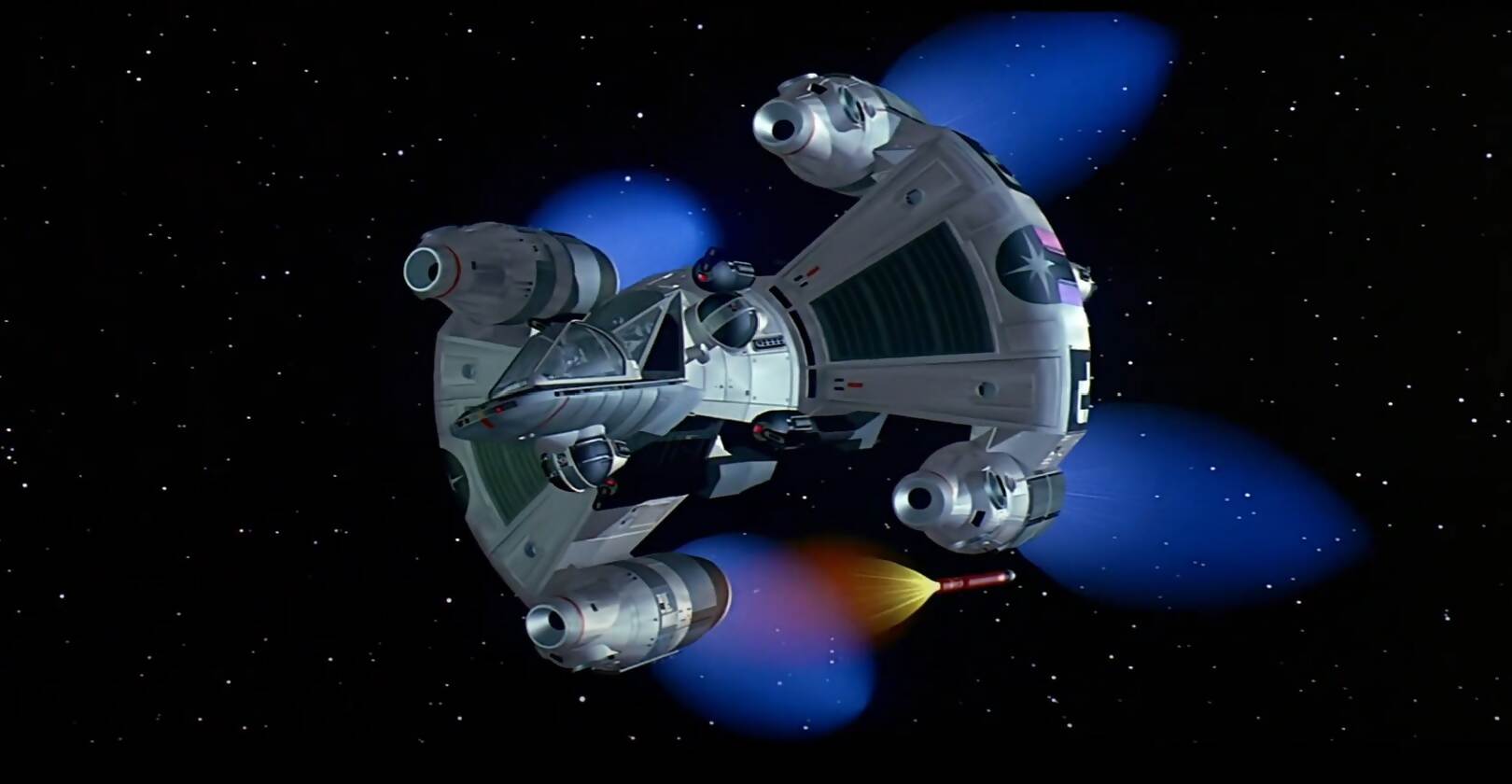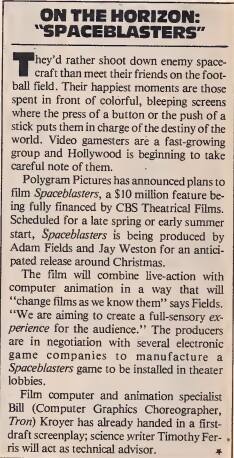
In the early 1980s, news emerged of an ambitious-sounding sci-fi adventure that used cutting-edge CGI. Then it vanished. We look at what happened to Spaceblasters.
It was one of winter 1982’s more eye-catching films: a sci-fi adventure filled with cutting-edge CGI effects and explosive action. Its marketing push included an arcade machine which could be played in the cinema’s lobby before you went in to see the movie itself. This was Spaceblasters – produced by Polygram Pictures and financed by CBS Theatrical Films to the tune of $10m, its budget was on a par with two of that year’s major releases, E.T. The Extra-Terrestrial and Poltergeist.
You may have seen the hole in this particular story, though: Spaceblasters never actually came out. In fact, look for it on the internet, and you’ll find next to nothing about it. (The image above, illustrating this piece, is from The Last Starfighter – a thematically similar film that came out in 1984. More on that shortly.)
The only real source of information on Spaceblasters came from the June 1982 edition of Starlog magazine. Amounting to half a column of text, tucked away on page 27, a news story talks about Spaceblasters in terms that, from the outside at least, made it sound like a project going full-steam into production.
Its producers were the Hollywood veteran Jay Weston (Lady Sings The Blues) and Adam Fields – the latter at the start of a career that eventually took in Money Train and Donnie Darko. Although little was shared about Spaceblasters’ plot, the news story says that the film was aimed squarely at the burgeoning videogame market.
“Video gamesters are a fast growing group,” Starlog’s piece reads, “and Hollywood is beginning to take careful note of them.”

That same year, Disney released TRON – a sci-fi fantasy that also aimed to capture a young audience who had an Atari 2600 console at home. Spaceblasters appeared to be patterned after that film, since TRON also had more than one tie-in videogame (and other merchandise) to help promote it.
Spaceblasters had something else in common with TRON: its screenwriter was Bill Kroyer, previously an animator at Disney. Earlier in the 1980s, he’d moved from hand-drawn animation to the then-new world of CGI, and served as Director of Animation on TRON (by this point, he’d moved from Disney to work with director Steven Lisberger).
We got in touch with Bill Kroyer to see if he could shed any light on Spaceblasters, and he very kindly replied to our email with some fascinating anecdotes.
Initially, Kroyer says, Spaceblasters went by the name Starblasters, and was written while he was working on TRON earlier in 1982.
“The screenplay was purchased by CBS Theatrical films,” Kroyer recalls. “David Obst was the producer supervising the project, I worked with him and did a polish, which we felt worked pretty well.”
As for the story itself, “it was a simple concept,” Kroyer says. He summarises it like this:
To protect earth from meteors, the government rings the planet with laser satellites. They create a video game with identical targeting gear as the real satellites and plant those games in arcades around the country. They then monitor the arcade game scores and ultimately draft the ten best players to train as satellite operators. The plan hits a curve when all ten winners happen to be punk kids.
When a real meteor shower threatens the earth, the government officials replace the kids with fighter pilots, but three of the kids (our heroes) refuse to be denied, break into the command centre, and ultimately save the earth.
After the script was written, “management changed” at CBS Theatrical, and according to Kroyer, it was here that producer Adam Fields entered the picture, and Starblasters became Spaceblasters – among other changes.
“Adam Fields took over the project and he brought in another writer to re-write me,” Kroyer says. “The result was ridiculous. They had the meteors turn into aliens with little faces. That version was killed and another re-write was ordered, this time done by a very good writer, Robin Swicord.”
(Swicord later wrote the adapted screenplays for Little Women (1994), Matilda (1996), among others, and both wrote and directed the 2016 horror, Wakefield.)
As of June 1982, Adam Fields was bullish about Spaceblasters' commercial prospects. The film, with its cutting edge computer graphics, was set to “change films as we know them,” he said, with the aim being to “create a full sensory experience for the audience.”
The production was also aiming for a certain level of realism, it seems, since it had hired science writer Timothy Ferris as its technical advisor. We also got in touch with Mr Ferris, whose books include The Science Of Liberty and Seeing In The Dark, and in his reply, he said he had no recollection of a project called Spaceblasters.
“Doesn’t ring a bell,” the author wrote, “but might have been one of the IMAX shows I worked on that never got made.”
According to Starlog, the film was scheduled to go into production in 1982, with an “anticipated release around Christmas.” (That sounds like a tight turnaround; it’s more likely that it was intended to come out in December 1983.)
So what happened to it? One obvious answer might be TRON itself. Writer-director Steven Lisberger’s videogame era fantasia came out in July 1982, just one month after the issue of Starlog quoted here was published. Making $50m on a $17m budget, it wasn’t exactly the Star Wars beater Disney might have hoped – though its ongoing cult appeal has given it a long half life. TRON: Legacy came out in 2010, while TRON: Ares is due this autumn.

This, along with the almighty North American videogame crash that unfolded later in 1982, might have dissuaded Spaceblasters’ financiers from putting money into the project. (Videogames in general were considered a defunct fad for a time in the US – a belief put to bed by the storming success of the Nintendo Entertainment System there in 1985.)
According to Bill Kroyer, however, there was a simpler explanation for Spaceblasters' disappearance.
“Alas,” he says, “The Last Starfighter went into production with a vaguely similar plot. It killed [Spaceblasters].”
The Last Starfighter, a sci-fi adventure aimed at gamers and also containing early cutting edge CGI, came out in 1984, and it did indeed see an arcade machine used as a training device for its unsuspecting players. Other films of the time also had space themes, such as Spacehunter: Adventures In The Forbidden Zone, filmed in glorious 3D and released in May 1983.
Kroyer soon got to work on another sci-fi film: he was key animator on the 1985 epic, Starchaser: The Legend Of Orin, which made pioneering (and labour-intensive) use of CGI and 3D. The production story of that movie is worthy of an article by itself.
None of these space adventures were big hits, but like TRON, they eventually earned their own cult followings years after.
As for Kroyer, he continued to have a long and successful career in the film industry. He directed FernGully: The Last Rainforest (the similarities between it and James Cameron’s 2009 space fantasy, Avatar, may or may not be coincidental), and his credits on other hit animated and live action films is vast.
In the early 1980s, studios all over the world, large and small, tried to make their own Star Wars. Some of the resulting films were good, some were bad; inevitably, none matched George Lucas’s epic fantasy in terms of era-defining success. But then there’s Spaceblasters: a film with grand-sounding ambitions that, thankfully, hasn’t quite fallen out of history altogether.








